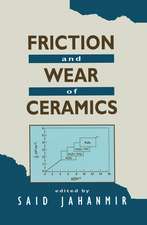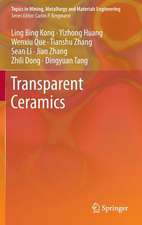How Glass Changed the World: The History and Chemistry of Glass from Antiquity to the 13th Century: SpringerBriefs in Molecular Science
Autor Seth C. Rasmussenen Limba Engleză Paperback – 24 feb 2012
Din seria SpringerBriefs in Molecular Science
-
 Preț: 411.46 lei
Preț: 411.46 lei -
 Preț: 379.09 lei
Preț: 379.09 lei -
 Preț: 356.49 lei
Preț: 356.49 lei -
 Preț: 441.25 lei
Preț: 441.25 lei -
 Preț: 389.70 lei
Preț: 389.70 lei -
 Preț: 376.22 lei
Preț: 376.22 lei -
 Preț: 348.77 lei
Preț: 348.77 lei -
 Preț: 345.14 lei
Preț: 345.14 lei -
 Preț: 347.69 lei
Preț: 347.69 lei -
 Preț: 346.70 lei
Preț: 346.70 lei -
 Preț: 376.43 lei
Preț: 376.43 lei -
 Preț: 342.14 lei
Preț: 342.14 lei -
 Preț: 375.23 lei
Preț: 375.23 lei -
 Preț: 375.23 lei
Preț: 375.23 lei -
 Preț: 379.09 lei
Preț: 379.09 lei -
 Preț: 376.59 lei
Preț: 376.59 lei -
 Preț: 378.12 lei
Preț: 378.12 lei -
 Preț: 376.59 lei
Preț: 376.59 lei -
 Preț: 376.59 lei
Preț: 376.59 lei -
 Preț: 375.23 lei
Preț: 375.23 lei -
 Preț: 351.18 lei
Preț: 351.18 lei -
 Preț: 377.73 lei
Preț: 377.73 lei -
 Preț: 372.73 lei
Preț: 372.73 lei -
 Preț: 378.54 lei
Preț: 378.54 lei -
 Preț: 376.96 lei
Preț: 376.96 lei -
 Preț: 377.35 lei
Preț: 377.35 lei -
 Preț: 378.12 lei
Preț: 378.12 lei -
 Preț: 376.04 lei
Preț: 376.04 lei -
 Preț: 346.59 lei
Preț: 346.59 lei -
 Preț: 375.45 lei
Preț: 375.45 lei -
 Preț: 377.73 lei
Preț: 377.73 lei -
 Preț: 381.00 lei
Preț: 381.00 lei -
 Preț: 377.18 lei
Preț: 377.18 lei -
 Preț: 376.96 lei
Preț: 376.96 lei -
 Preț: 380.07 lei
Preț: 380.07 lei -
 Preț: 376.22 lei
Preț: 376.22 lei -
 Preț: 343.72 lei
Preț: 343.72 lei -
 Preț: 376.22 lei
Preț: 376.22 lei -
 Preț: 377.35 lei
Preț: 377.35 lei -
 Preț: 343.72 lei
Preț: 343.72 lei -
 Preț: 376.22 lei
Preț: 376.22 lei -
 Preț: 375.07 lei
Preț: 375.07 lei -
 Preț: 374.85 lei
Preț: 374.85 lei - 15%
 Preț: 464.97 lei
Preț: 464.97 lei -
 Preț: 376.43 lei
Preț: 376.43 lei -
 Preț: 341.75 lei
Preț: 341.75 lei -
 Preț: 374.30 lei
Preț: 374.30 lei -
 Preț: 375.23 lei
Preț: 375.23 lei -
 Preț: 377.57 lei
Preț: 377.57 lei
Preț: 461.73 lei
Preț vechi: 543.21 lei
-15% Nou
Puncte Express: 693
Preț estimativ în valută:
88.36€ • 94.48$ • 73.67£
88.36€ • 94.48$ • 73.67£
Carte tipărită la comandă
Livrare economică 18 aprilie-02 mai
Preluare comenzi: 021 569.72.76
Specificații
ISBN-13: 9783642281822
ISBN-10: 3642281826
Pagini: 70
Ilustrații: X, 85 p. 32 illus., 14 illus. in color.
Dimensiuni: 155 x 235 x 18 mm
Greutate: 0.16 kg
Ediția:2012
Editura: Springer Berlin, Heidelberg
Colecția Springer
Seriile SpringerBriefs in Molecular Science, History of Chemistry
Locul publicării:Berlin, Heidelberg, Germany
ISBN-10: 3642281826
Pagini: 70
Ilustrații: X, 85 p. 32 illus., 14 illus. in color.
Dimensiuni: 155 x 235 x 18 mm
Greutate: 0.16 kg
Ediția:2012
Editura: Springer Berlin, Heidelberg
Colecția Springer
Seriile SpringerBriefs in Molecular Science, History of Chemistry
Locul publicării:Berlin, Heidelberg, Germany
Public țintă
ResearchCuprins
Origins of glass: Myth and known history.- Development and growth of glass through the Roman period.- Reinventing an old material: Venice and the new glass.- Applications to chemical apparatus.- Impact on society and its effect on chemical progress.
Recenzii
“This book is exciting and enjoyable to read, especially for anyone who is interested in glass. The book provides a dynamic introduction to glass via the history of glassmaking … . this book is highly recommended, whether you are a novice or an expert in glass research or you are just interested in glass and glassmaking. It is easy to read and understand, even for those individuals with minimal background knowledge in science and chemistry. This is a must read!” (Michael B. Jacobs, Journal of Chemical Education, Vol. 92 (3), 2015)
Notă biografică
Seth C. Rasmussen is an Associate Professor of Chemistry at North Dakota State University (NDSU) in Fargo (seth.rasmussen@ndsu.edu). He received his B.S in Chemistry from
Washington State University in 1990 and his Ph.D. in Inorganic Chemistry from Clemson University in 1994, under the guidance of Prof. John D. Peterson. As a postdoctoral associate at
the University of Oregon, he then studied conjugated organic polymers under Prof. James E. Hutchison. In 1997, he accepted a teaching position at the University of Oregon, before moving
to join the faculty at NDSU in 1999. Active in the fields of materials chemistry and the history of chemistry, his research interests
include the design and synthesis of conjugated materials, photovoltaics (solar cells), organic light emitting diodes, the application of history to chemical education, the history of materials, and chemical technology in antiquity. As both author and editor, Prof. Rasmussen has contributed to books in both materials and history and has published more than 50 research papers. He is a
member of various international professional societies including the American Chemical Society, Materials Research Society, Alpha Chi Sigma, Society for the History of Alchemy and Chemistry, and the International History, Philosophy & Science Teaching Group.
Prof. Rasmussen currently serves as the Program Chair for the History of Chemistry division of the American Chemical Society and as Series Editor for Springer Briefs in Molecular Science: History of Chemistry.
Washington State University in 1990 and his Ph.D. in Inorganic Chemistry from Clemson University in 1994, under the guidance of Prof. John D. Peterson. As a postdoctoral associate at
the University of Oregon, he then studied conjugated organic polymers under Prof. James E. Hutchison. In 1997, he accepted a teaching position at the University of Oregon, before moving
to join the faculty at NDSU in 1999. Active in the fields of materials chemistry and the history of chemistry, his research interests
include the design and synthesis of conjugated materials, photovoltaics (solar cells), organic light emitting diodes, the application of history to chemical education, the history of materials, and chemical technology in antiquity. As both author and editor, Prof. Rasmussen has contributed to books in both materials and history and has published more than 50 research papers. He is a
member of various international professional societies including the American Chemical Society, Materials Research Society, Alpha Chi Sigma, Society for the History of Alchemy and Chemistry, and the International History, Philosophy & Science Teaching Group.
Prof. Rasmussen currently serves as the Program Chair for the History of Chemistry division of the American Chemical Society and as Series Editor for Springer Briefs in Molecular Science: History of Chemistry.
Textul de pe ultima copertă
Glass production is thought to date to ~2500 BC and had found numerous uses by the height of the Roman Empire. The modern view of glass-based chemical apparatus (beakers, flasks, stills, etc.) was quite limited, however, due to a lack of glass durability under rapid temperature changes and chemical attack. In the mid 1200s, this began to change as the glassmakers of Venice and Murano began blending previous Roman methods with raw materials from the Levant, as well as developing pretreatment and purification methods of the raw materials used. The combination of these practices resulted in a new glass with a strength and high melting point suitable for use in chemical apparatus. The ability to produce vessels from glass allowed much greater freedom and versatility in the design of chemical apparatus. In addition, the resulting improved glass technology lead to the invention of eyeglasses and a vast improvement in still design, which in turn allowed the isolation of important materials such as alcohol and the mineral acids. This text will give an overview of the history and chemistry of glass technology from its origins in antiquity to its dramatic expansion in the 13th century, concluding with its impact on society in general, particularly its affect on chemical practices.
Caracteristici
Provides an overview of the history and chemistry of glass technology Describes the impact glass has had on society today especially on chemical practices Includes supplementary material: sn.pub/extras




















